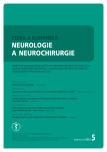The Pilot Study of the Use of Force Platform in Home-based Therapy of Balance Disorders
Authors:
M. Janatová 1,2; M. Tichá 1,2; R. Melecký 1; K. Hána 1; O. Švestková 1,2; J. Jeřábek 1,3
Authors‘ workplace:
Společné pracoviště biomedicínského inženýrství FBMI ČVUT a 1. LF UK, Praha
1; Klinika rehabilitačního lékařství 1. LF UK a VFN v Praze
2; Neurologická klinika 2. LF UK a FN v Motole, Praha
3
Published in:
Cesk Slov Neurol N 2016; 79/112(5): 591-594
Category:
Short Communication
Overview
Aim:
The aim of the pilot study was to verify usability of a newly developed system that utilizes a force platform and visual feedback for home-based balance training.
Material and methods:
The pilot study was performed in 14 respondents (13 women and one man) with the mean age of 67 ± 7 years. The balance training took place in domestic environment for a period of 26 days with the use of interactive system employing the principle of visual feedback. All volunteers reported subjective perception of balance issues but no significant objective risk of fall was diagnosed. Non-parametric Friedman’s test was used to evaluate the effect of the therapy.
Results:
The results showed that the time required to finish the same reference training scene significantly decreased at the level of significance of 0.001 (chi-square = 113.56, s.v. = 21, n = 14; p = 0.001). All subjects improved their ability to react to scene changes in virtual environment by shifting their centre of gravity.
Conclusion:
We verified usability of this custom-developed system for home-based balance training. Further randomized study incorporating larger data set is needed to validate the effect of the therapy.
Key words:
visual feedback – force platform – rehabilitation – balance disorders – home-based therapy
The authors declare they have no potential conflicts of interest concerning drugs, products, or services used in the study.
The Editorial Board declares that the manuscript met the ICMJE “uniform requirements” for biomedical papers.
Sources
1. Strupp M, Arbusow V, Maag KP, et al. Vestibular exercises improve central vestibulospinal compensation after vestibular neuritis. Neurology 1998; 51 (3): 838–44.
2. Čakrt O, Vyhnálek M, Slabý K, et al. Balance rehabilitation therapy by tongue electrotactile biofeedback in patients with degenerative cerebellar disease. NeuroRehabilitation 2012; 31 (4): 429–34. doi: 10.3233/NRE-2012-00813.
3. Kalitová P, Čakrt O, Čada Z, et al. Význam vestibulárního a posturografického vyšetření u pacientů s vestibulárním schwannomem. Cesk Slov Neurol N 2013; 76/ 109 (4): 469–74.
4. Darekar A, McFadyen B, Lamontagne A, et al. Efficacy of virtual reality-based intervention on balance and mobility disorders post-stroke: a scoping review. J Neuroeng Rehabil 2015; 12 (1): 46. doi: 10.1186/s12984-015-00 35-3.
5. Chao Y, Scherer Y, Montgomery C. Effects of using Nintendo Wii exergames in older adults: a review of the literature. J Aging Health 2014; 27 (3): 379–402. doi: 10.1177/0898264314551171.
6. Gil-Gomez J, Lloréns R, Alcaniz M, et al. Effectiveness of a Wii balance board-based system (eBaViR) for balance rehabilitation: a pilot randomized clinical trial in patients with acquired brain injury. J Neuroeng Rehabil 2011; 8 (1): 30. doi: 10.1186/1743-0003-8-30.
7. Jalink M, Heineman E, Pierie J, et al. Nintendo related injuries and other problems: review. BMJ 2014; 349: 7267. doi: 10.1136/bmj.g7267.
8. Bartlett H, Ting L, Bingham J. Accuracy of force and center of pressure measures of the Wii Balance Board. Gait Posture 2014; 39 (1): 224–8. doi: 10.1016/j.gaitpost.2013.07.010.
9. Janatová M, Tichá M, Gerlichová M, et al. Terapie poruch rovnováhy u pacientky po cévní mozkové příhodě s využitím vizuální zpětné vazby a stabilometrické plošiny v domácím prostředí. Rehabilitácia 2015; 52 (3): 140–6.
Labels
Paediatric neurology Neurosurgery NeurologyArticle was published in
Czech and Slovak Neurology and Neurosurgery

2016 Issue 5
Most read in this issue
- Current Corticosteroid Treatment in Brain Tumours
- Rasmussen’s Encephalitis
- Traumatic Brachial Plexus Injuries Represents Serious Peripheral Nerve Palsies
- Detection of Spirochetal DNA from Patients with Neuroborreliosis
